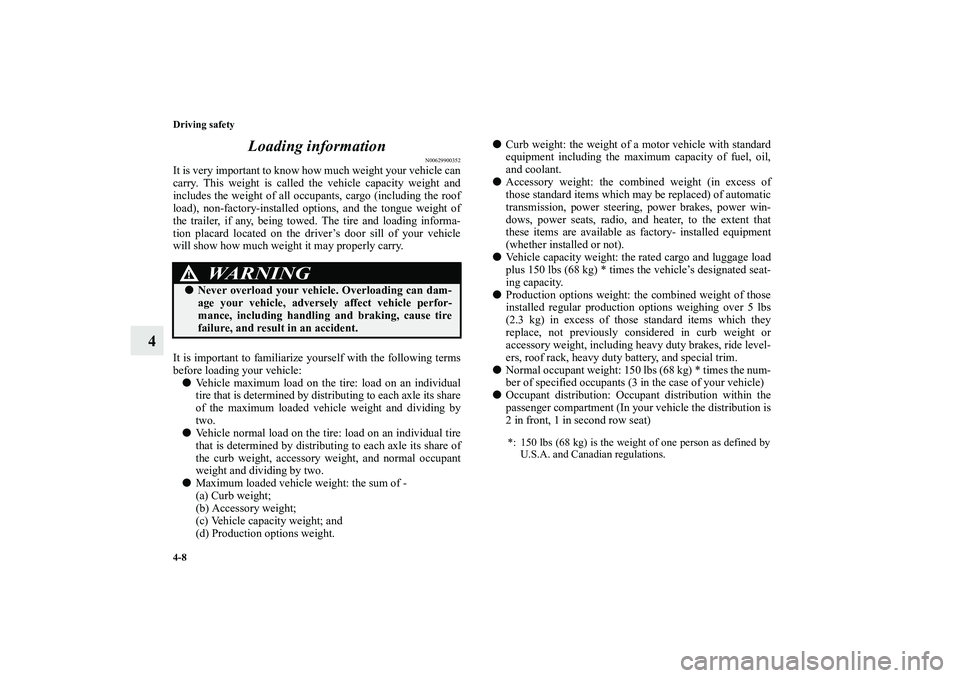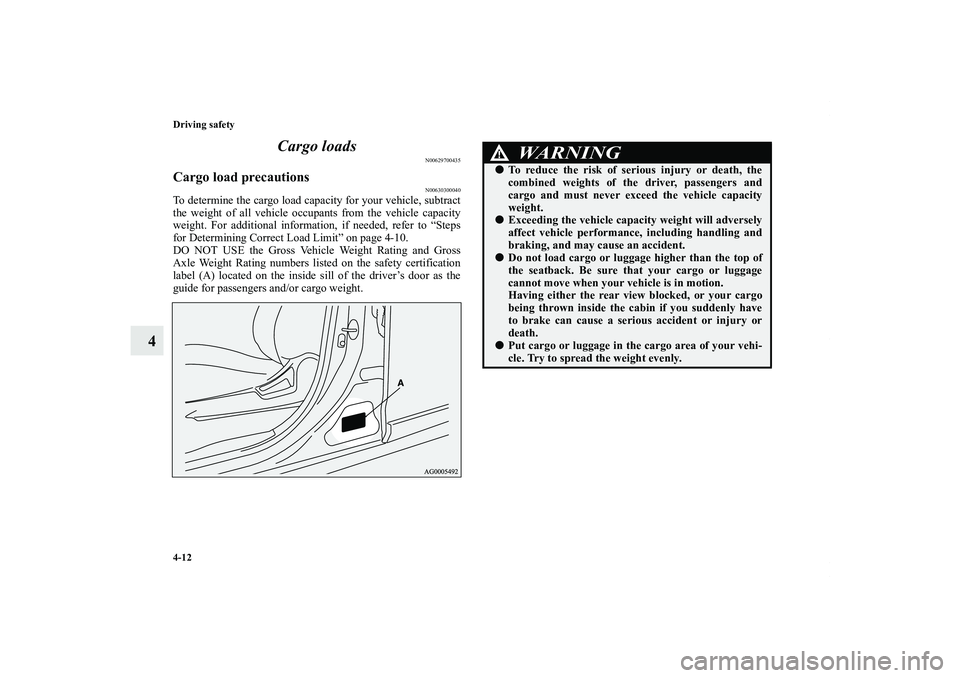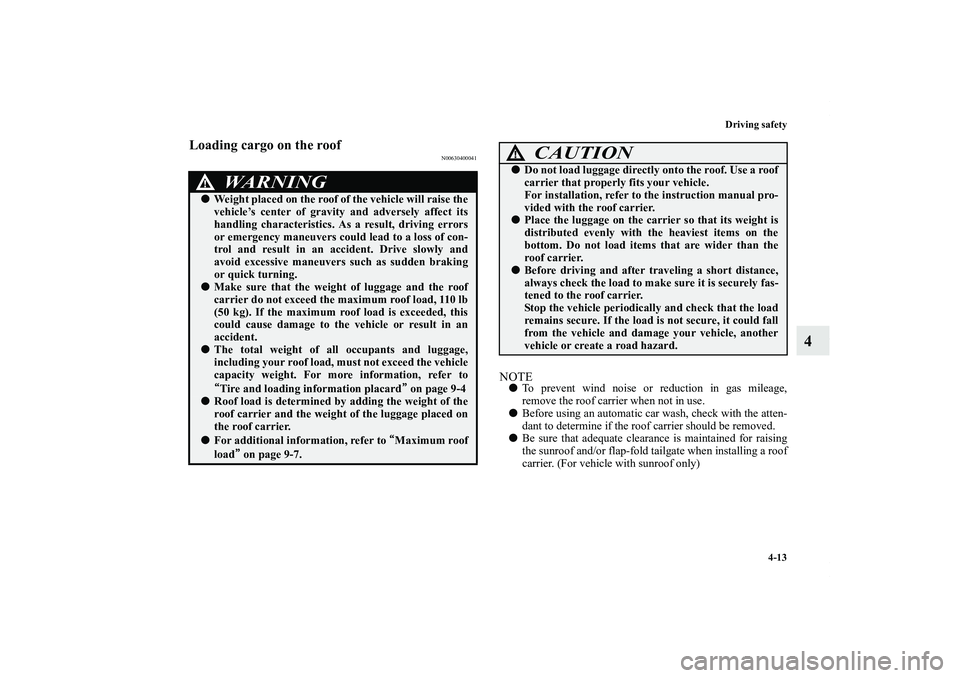Page 98 of 714

Seat and restraint systems
2-71
2
Driver’s and passenger’s front airbag system
N00407900305
The driver’s airbag is located under the padded cover in the
middle of the steering wheel. The front passenger’s airbag is
contained in the instrument panel above the glove compart-
ment. The driver’s airbag and the front passenger’s airbag are
designed to deploy at the same time. However, the front pas-
senger’s airbag does not deploy when the front passenger seat
is not occupied or when the weight sensor in the front passen-
ger seat senses a weight on the seat of less than approximately
66 pounds (30 kg).
WA R N I N G
!�There may be a system error if the warning
light/display appears as indicated. In such cases, an
SRS airbag or a seat belt equipped with pre-ten-
sioner system may not function properly in a colli-
sion. Have your vehicle checked by an authorized
Mitsubishi Motors dealer:
• Even when the ignition switch is in the “ON” posi-
tion, the warning light does not come on or it
remains on a few seconds later
• When warning light comes on while driving
• When warning display appears while driving
Driver
Front passenger
BK0122500US.book 71 ページ 2010年5月12日 水曜日 午前11時11分
Page 400 of 714
Features and controls
3-285
3
To remove1. Roll back the cargo area cover.
2. Move one of the sliders (C) toward the inside of the vehi-
cle and lift it to remove the cargo area cover.
To fit the cargo area cover, follow the removal steps in reverse.
Gently shake the entire cargo area cover after fitting it to make
sure it is securely retained.
Assist grips
N00559000032
The assist grips (located above the doors on the headliner) are
not designed to support body weight. They are intended for use
only while seated in the vehicle.
CAUTION
!�Do not use the assist grips when getting into or out
of the vehicle. The assist grips could detach causing
you to fall.
BK0122500US.book 285 ページ 2010年5月12日 水曜日 午前11時11分
Page 411 of 714

4-8 Driving safety
4Loading information
N00629900352
It is very important to know how much weight your vehicle can
carry. This weight is called the vehicle capacity weight and
includes the weight of all occupants, cargo (including the roof
load), non-factory-installed options, and the tongue weight of
the trailer, if any, being towed. The tire and loading informa-
tion placard located on the driver’s door sill of your vehicle
will show how much weight it may properly carry.
It is important to familiarize yourself with the following terms
before loading your vehicle:
�Vehicle maximum load on the tire: load on an individual
tire that is determined by distributing to each axle its share
of the maximum loaded vehicle weight and dividing by
two.
�Vehicle normal load on the tire: load on an individual tire
that is determined by distributing to each axle its share of
the curb weight, accessory weight, and normal occupant
weight and dividing by two.
�Maximum loaded vehicle weight: the sum of -
(a) Curb weight;
(b) Accessory weight;
(c) Vehicle capacity weight; and
(d) Production options weight.�Curb weight: the weight of a motor vehicle with standard
equipment including the maximum capacity of fuel, oil,
and coolant.
�Accessory weight: the combined weight (in excess of
those standard items which may be replaced) of automatic
transmission, power steering, power brakes, power win-
dows, power seats, radio, and heater, to the extent that
these items are available as factory- installed equipment
(whether installed or not).
�Vehicle capacity weight: the rated cargo and luggage load
plus 150 lbs (68 kg) * times the vehicle’s designated seat-
ing capacity.
�Production options weight: the combined weight of those
installed regular production options weighing over 5 lbs
(2.3 kg) in excess of those standard items which they
replace, not previously considered in curb weight or
accessory weight, including heavy duty brakes, ride level-
ers, roof rack, heavy duty battery, and special trim.
�Normal occupant weight: 150 lbs (68 kg) * times the num-
ber of specified occupants (3 in the case of your vehicle)
�Occupant distribution: Occupant distribution within the
passenger compartment (In your vehicle the distribution is
2 in front, 1 in second row seat)
WA R N I N G
!�Never overload your vehicle. Overloading can dam-
age your vehicle, adversely affect vehicle perfor-
mance, including handling and braking, cause tire
failure, and result in an accident.
*: 150 lbs (68 kg) is the weight of one person as defined by
U.S.A. and Canadian regulations.
BK0122500US.book 8 ページ 2010年5月12日 水曜日 午前11時11分
Page 412 of 714
Driving safety
4-9
4
Tire and loading information placard
N00630100325
The tire and loading information placard is located on the
inside sill of the driver’s door.This placard shows the maximum number of occupants permit-
ted to ride in your vehicle as well as “the combined weight of
occupants and cargo” (A), which is called the vehicle capacity
weight. The weight of any non-factory installed options, as
well as the tongue weight of a trailer being towed and roof load
is included in the definition of “cargo” when determining the
vehicle capacity weight. This placard also tells you the size and
recommended inflation pressure for the original equipment
tires on your vehicle. For more information, refer to “Tires” on
page 7-24.
Ty p e 1
BK0122500US.book 9 ページ 2010年5月12日 水曜日 午前11時11分
Page 413 of 714

4-10 Driving safety
4
Ty p e 2
Steps for Determining Correct Load Limit
N00630200094
1. Locate the statement “The combined weight of occu-
pants and cargo should never exceed XXX kg or XXX
lbs.” on your vehicle’s placard.
2. Determine the combined weight of the driver and pas-
sengers that will be riding in your vehicle.
3. Subtract the combined weight of the driver and passen-
gers from XXX kg or XXX lbs.
4. The resulting figure equals the available amount of
cargo and luggage load capacity. For example, if the
“XXX” amount equals 1400 lbs. and there will be five
150 lbs. passengers in your vehicle, the amount of
available cargo and luggage load capacity is 650 lbs.
(1400 - 750 (5 x 150) = 650 lbs.)
5. Determine the combined weight of luggage and cargo
being loaded on the vehicle. That weight may not
safely exceed the available cargo and luggage load
capacity calculated in Step 4.
6. If your vehicle will be towing a trailer, load from your
trailer will be transferred to your vehicle. Consult this
manual to determine how this reduces the available
cargo and luggage load capacity of your vehicle.
BK0122500US.book 10 ページ 2010年5月12日 水曜日 午前11時11分
Page 414 of 714
Driving safety
4-11
4
NOTE�The following table shows examples on how to calculate total load, cargo/luggage and towing capacities of your vehicle
with varying seating configurations and number and size of occupants. This table is for illustration purposes only and
may not be accurate for the seating and load carry capacity of your vehicle.
�For the following example the combined weight of occupants and cargo should never exceed 865 lbs (392 kg).
�Under a maximum loaded vehicle condition, gross axle weight ratings (GAWR’s) for the front and rear axles must not be
exceeded. For further information on GAWR’s, vehicle loading and trailer towing, see the “Specifications” section of
this manual.
BK0122500US.book 11 ページ 2010年5月12日 水曜日 午前11時11分
Page 415 of 714

4-12 Driving safety
4Cargo loads
N00629700435
Cargo load precautions
N00630300040
To determine the cargo load capacity for your vehicle, subtract
the weight of all vehicle occupants from the vehicle capacity
weight. For additional information, if needed, refer to “Steps
for Determining Correct Load Limit” on page 4-10.
DO NOT USE the Gross Vehicle Weight Rating and Gross
Axle Weight Rating numbers listed on the safety certification
label (A) located on the inside sill of the driver’s door as the
guide for passengers and/or cargo weight.
WA R N I N G
!�To reduce the risk of serious injury or death, the
combined weights of the driver, passengers and
cargo and must never exceed the vehicle capacity
weight.�Exceeding the vehicle capacity weight will adversely
affect vehicle performance, including handling and
braking, and may cause an accident.�Do not load cargo or luggage higher than the top of
the seatback. Be sure that your cargo or luggage
cannot move when your vehicle is in motion.
Having either the rear view blocked, or your cargo
being thrown inside the cabin if you suddenly have
to brake can cause a serious accident or injury or
death.�Put cargo or luggage in the cargo area of your vehi-
cle. Try to spread the weight evenly.
BK0122500US.book 12 ページ 2010年5月12日 水曜日 午前11時11分
Page 416 of 714

Driving safety
4-13
4
Loading cargo on the roof
N00630400041
NOTE�To prevent wind noise or reduction in gas mileage,
remove the roof carrier when not in use.
�Before using an automatic car wash, check with the atten-
dant to determine if the roof carrier should be removed.
�Be sure that adequate clearance is maintained for raising
the sunroof and/or flap-fold tailgate when installing a roof
carrier. (For vehicle with sunroof only)
WA R N I N G
!�Weight placed on the roof of the vehicle will raise the
vehicle’s center of gravity and adversely affect its
handling characteristics. As a result, driving errors
or emergency maneuvers could lead to a loss of con-
trol and result in an accident. Drive slowly and
avoid excessive maneuvers such as sudden braking
or quick turning.�Make sure that the weight of luggage and the roof
carrier do not exceed the maximum roof load, 110 lb
(50 kg). If the maximum roof load is exceeded, this
could cause damage to the vehicle or result in an
accident.�The total weight of all occupants and luggage,
including your roof load, must not exceed the vehicle
capacity weight. For more information, refer to
“
““ “Tire and loading information placard”
”” ” on page 9-4�Roof load is determined by adding the weight of the
roof carrier and the weight of the luggage placed on
the roof carrier.�For additional information, refer to “
““ “Maximum roof
load”
”” ” on page 9-7.
CAUTION
!�Do not load luggage directly onto the roof. Use a roof
carrier that properly fits your vehicle.
For installation, refer to the instruction manual pro-
vided with the roof carrier.�Place the luggage on the carrier so that its weight is
distributed evenly with the heaviest items on the
bottom. Do not load items that are wider than the
roof carrier.�Before driving and after traveling a short distance,
always check the load to make sure it is securely fas-
tened to the roof carrier.
Stop the vehicle periodically and check that the load
remains secure. If the load is not secure, it could fall
from the vehicle and damage your vehicle, another
vehicle or create a road hazard.
BK0122500US.book 13 ページ 2010年5月12日 水曜日 午前11時11分